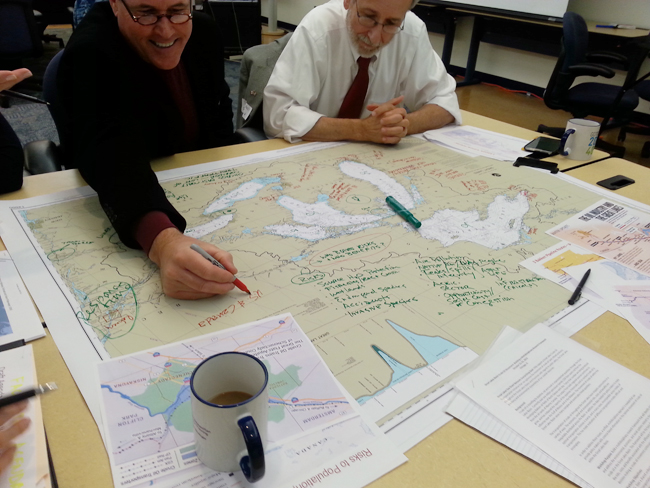
New York Sea Grant is helping concerned stakeholders better understand the opportunities, risks, and hazards based on the best science and technology associated with the transport of crude oil in the Great Lakes, Lake Champlain and Hudson River watershed. For more, see New York Sea Grant's recent impact statement, "Applying Science to Understanding Crude Oil Transport in the Great Lakes and Beyond" (pdf)
Recently-released research papers and new Web site — both highlights of the event —
present U.S. and Canadian government, industry, academic and
non-governmental organization stakeholders with the facts about crude
oil transport in the Great Lakes
Contact:
Katherine Bunting-Howarth, New York Sea Grant Associate Director; Cornell Cooperative Extension Assistant Director, E: keb264@cornell.edu, P: 607-255-2832
Kara Lynn Dunn, NYSG Publicist, E: karalynn@gisco.net, P: 315-465-7578
Beth Wanamaker, Great Lakes Commission, E: beth@glc.org, P: 734-396-6082
Michèle Leduc-Lapierre, Great Lakes Commission, E: michelel@glc.org
Cleveland, OH, June 6, 2017 - Each day all over North America, millions of gallons of crude oil move by pipeline, truck and train, fueling the economy with jobs and industry. But the risk of pipeline leaks and train derailments give residents in communities along the transport routes pause.
To help stakeholders understand the complexities of how crude oil is transported, the Great Lakes Sea Grant Network has worked with international partners to launch an informative Web site, www.glslcrudeoiltransport.org.
Helping to further this topical discussion, the United States and Canadian governments, and stakeholders from industry, academic and non-governmental organizations will convene on June 8-9, 2017 in Cleveland, Ohio for “Crude Move: Oil Transportation Infrastructure, Economics, Risks, Hazards and Lessons Learned,” a first-of-its-kind crude oil movement symposium that is open to the public via Webinar.
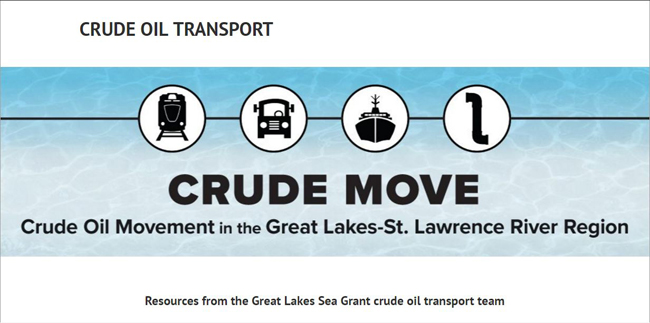
Great Lakes Sea Grant Network Web site, www.glslcrudeoiltransport.org
The areas of focus for the event include the Great Lakes-St. Lawrence River Basin and northern watersheds including Lake Champlain and the Hudson River.
"Every day we use products made from crude oil, but we rarely take the time to think about how it travels from the point of extraction and into the final product," said New York Sea Grant Associate Director and symposium co-leader Katherine Bunting-Howarth (Great Lakes Commission's Michele Leduc-Lapierre is also a lead). "This symposium presents an opportunity to learn about how crude oil moves through the Basin, how it affects people, communities and the environment from a spill."
The symposium, presented in with funding from the Gulf of Mexico Research Initiative and in part from the Joyce Foundation, is hosted by the Great Lakes Sea Grant Network (Illinois-Indiana, Lake Champlain, Michigan, Minnesota, New York, Ohio, Pennsylvania and Wisconsin); the Sea Grant programs in the Gulf of Mexico (Texas, Louisiana, Florida and Mississippi-Alabama); the Great Lakes Commission (GLC) and the International Joint Commission (IJC).
"One of Sea Grant’s strengths is our national network that allows us to share resources, lessons learned, and examples of successes across regions," said Larissa Graham, Oil Spill Science Extension Specialist with the Mississippi-Alabama Sea Grant Consortium. "This symposium is a great opportunity for us to provide oil spill science from the Gulf of Mexico to our Great Lakes Sea Grant programs and partners in hopes that it can help them better prepare for future disasters."
“If you have ever wanted to better understand how crude oil moves by
rail, pipeline, highway and water or wondered about the risks involved, these webinars provide the opportunity to hear from
experts on these topics as well as on lessons learned from the Deepwater
Horizon spill in the Gulf of Mexico and spills in the Great Lakes-St.
Lawrence River region,” added Bunting-Howarth, who is also Assistant Director for Cornell Cooperative Extension.
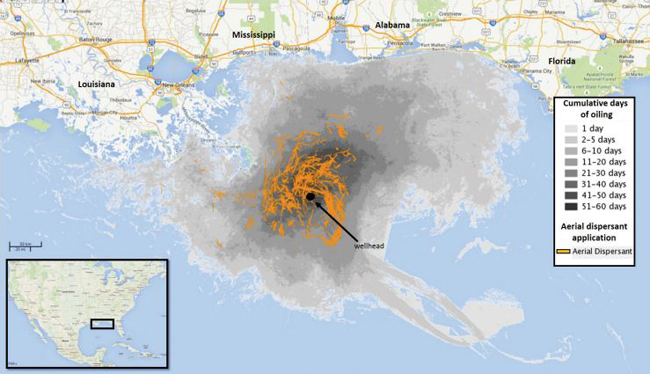
This map shows areas that were oiled during 2010's Deepwater Horizon oil spill (gray) and where dispersants were applied via plane (orange). Dispersants were also sprayed by boats and at subsurface depths (not shown on this map). Photo: Environmental Response Management Application. Source: Sea Grant in the Gulf of Mexico - Oil Spill Outreach
In Focus: Discussions at Crude Move Symposium
Symposium topics include regional transportation, how crude moves, economics and a financial analysis of the region's oil industry, hazards and risk, emergency response and lessons learned from the Great-Lakes and St. Lawrence River region and the New Horizon oil rig explosion in the Gulf of Mexico.
"Crude oil and its refined products take many forms and affect people's mobility, national security, economy, environmental health and quality of life," said Minnesota Sea Grant Maritime Extension Educator and risk panel moderator Dale Bergeron. "We hope to create a meeting at which all participants can have an honest conversation about risk and hazard."
The extraction, refinement and distribution of crude oil within the Great Lakes Basin moves by truck, by rail and by pipeline. Although pipelines are the preferred and more heavily used mode of transportation, there are objections to their use and to specific routes due to human health and environmental concerns. A 2016 headline from Forbes says it well: "Pipelines: The Worst Way to Move Oil, Except for All the Rest."
A symposium panel on different perspectives of risk includes presentations and discussions on transportation risk, human health and societal risks, and risk from the industry and insurance perspectives. "It's not only risk we have to define, we have to define how we look at cost and benefits," said Bergeron. "And, how we look at moving risk from one area to another."
Another topic of discussion at the symposium will be the three recently-released research papers that focused on key aspects of oil transportation in the Great Lakes-St. Lawrence River region, including the current state of crude oil infrastructure, the economic impact of crude oil transportation, and environmental sensitivity of Great Lakes waters to oil exposure. The papers were commissioned by the GLC through a grant from the C.S. Mott Foundation.
The release of these papers is a continuation of work by the GLC on key issues associated with oil transportation in the Great Lakes-St. Lawrence River region. The opinions, findings, and conclusions expressed in the papers are those of the authors and do not necessarily represent the views of the GLC or its member states and provinces
“Oil development is booming in the United States and Canada, but this increase has raised many questions about current and upcoming risks and opportunities associated with oil transportation to and through the Great Lakes-St. Lawrence region,” said GLC executive director Tim Eder. “These papers are aimed at answering some of those risk-related questions so we can appropriately support economic development while protecting the health of our waters.”
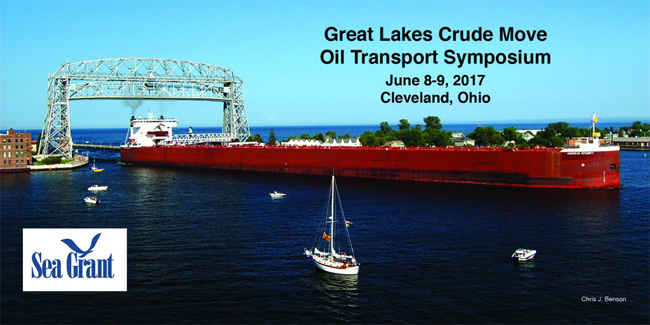
A Lake Superior Lake Freighter, also called a Laker, passes under the Aerial Lift Bridge that spans the Duluth Ship Canal on its way to the Duluth-Superior Harbor on the western arm of Lake Superior. The Great Lakes region is the world's fourth largest economy with annual economic output of nearly $5 trillion. Photograph: Chris J. Benson.
Symposium Information:
"Crude Move Symposium: Oil Transportation Infrastructure, Economics, Risk, Hazards and Lessons Learned."
June 8-9, 2017
Thursday 1:00 - 5:30 p.m.
Friday 8:30 a.m. - 2:00 p.m.
Great Lakes Ballroom
Drury Plaza Downtown Cleveland
1380 East Sixth Street
Cleveland, OH 44114
Draft Agenda (pdf)
Web site: www.glslcrudeoiltransport.org/symposium
Webinar
Day 1 Webinar Registration:
Meeting number: 808 125 205 / Meeting password: oilspill
And then, join by phone: 1-888-848-0190
Code: 8096626#
Day 2 Webinar Registration:
Meeting number: 808 271 893 / Meeting password: oilspill
And then, join by phone: 1-888-848-0190
Code: 8096626#
More Info: Crude Move Resources
Designed specifically to inform stakeholders of the movement of crude oil from the Great Lakes—St. Lawrence River region, the Great Lakes Sea Grant Network's www.glslcrudeoiltransport.org presents fact sheets and reports on crude oil transport as well as an archive of four downloadable webinars hosted in 2016 by Ohio Sea Grant.
Additionally, the Great Lakes Commission features its work on oil transportation in the Great Lakes at www.glc.org/work/oil-transportation.
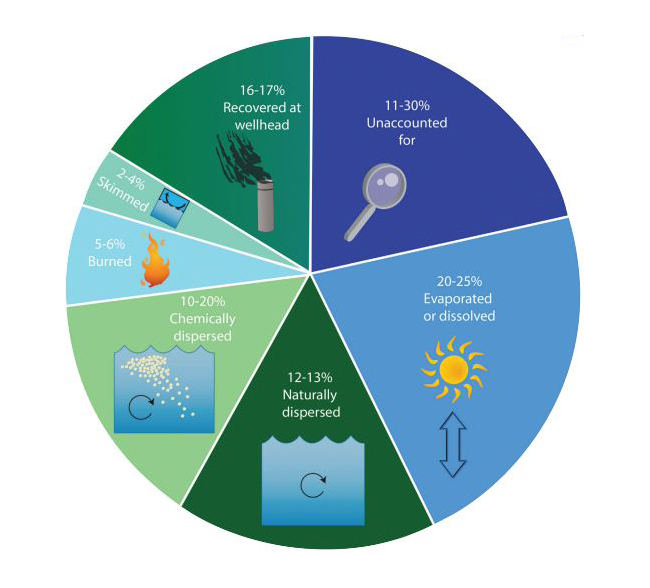
An estimate of what happened to approximately 200 million gallons oil from the DWH oil spill. Data from Lehr, 2014. Photo: Florida Sea Grant/Anna Hinkeldey.
Source: Sea Grant in the Gulf of Mexico - Oil Spill Outreach
More Info: New York Sea Grant
New York Sea Grant (NYSG), a cooperative program of Cornell University
and the State University of New York, is one of 33 university-based
programs under the National Sea Grant College Program (NSGCP) of the
National Oceanic and Atmospheric Administration (NOAA). The NSGCP
engages this network of the nation’s top universities in conducting
scientific research, education, training and extension projects designed
to foster science-based decisions about the use and conservation of our
aquatic resources. Through its statewide network of integrated
services, NYSG has been promoting coastal vitality, environmental
sustainability, and citizen awareness about the State’s marine and Great
Lakes resources since 1971.
New York Sea Grant maintains Great Lakes offices at SUNY Buffalo, the
Wayne County Cooperative Extension office in Newark and at SUNY Oswego.
In the State's marine waters, NYSG has offices at Stony Brook University
and Stony Brook Manhattan, in the Hudson Valley through Cooperative
Extension in Kingston and at Brooklyn College.
For updates on Sea Grant activities: www.nyseagrant.org has RSS, Facebook, Twitter, and YouTube links. NYSG produces a monthly e-newsletter, "NOAA Sea Grant's Social Media Review," via its blog, www.nyseagrant.org/blog. Our program also offers a free e-list sign up via www.nyseagrant.org/coastlines for its flagship publication, NY Coastlines/Currents, which is published 1-2 times a year.